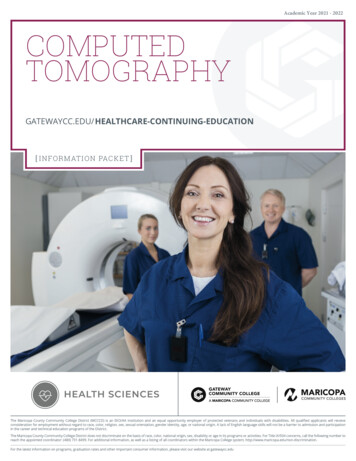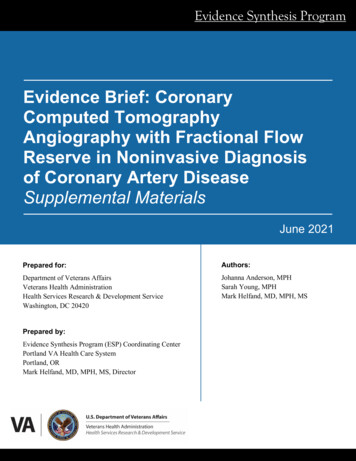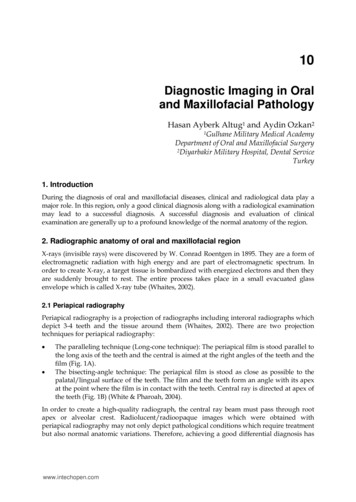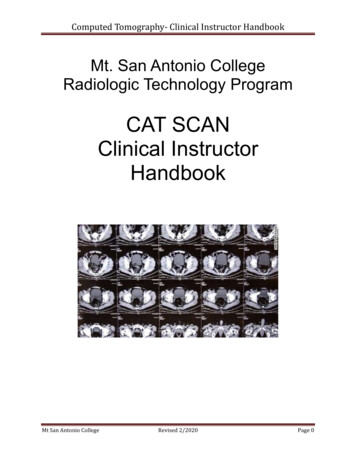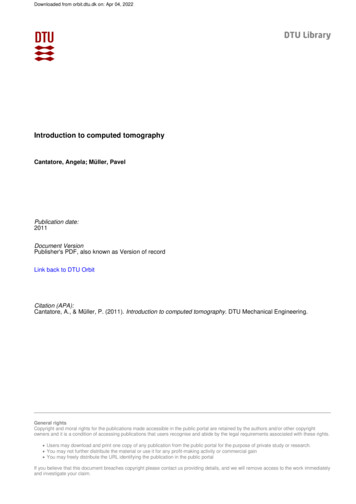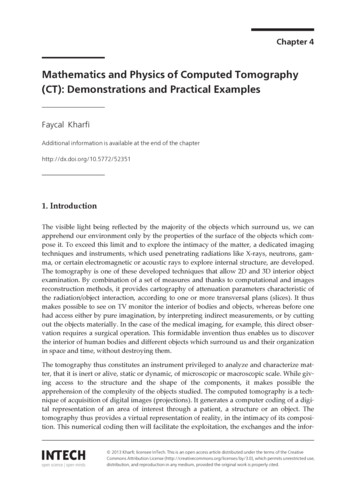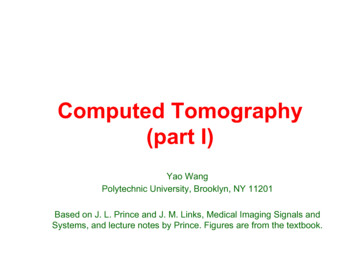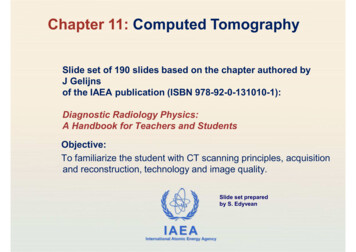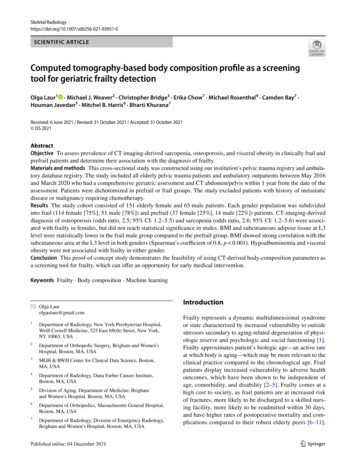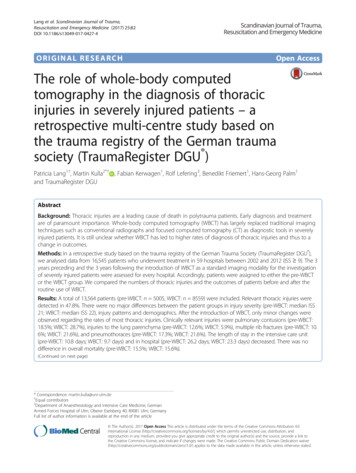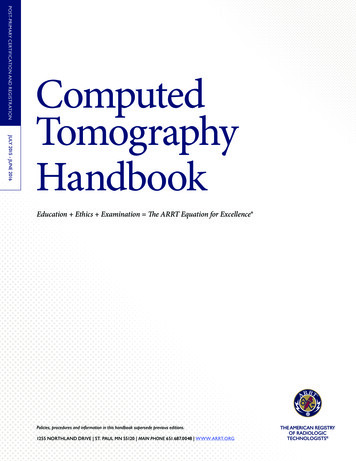
Transcription
ARRT IONANDREGISTRATIONJULY 2015 - JUNE 2016ComputedTomographyHandbookEducation Ethics Examination The ARRT Equation for Excellence Policies, procedures and information in this handbook supersede previous editions.1255 NORTHLAND DRIVE ST. PAUL MN 55120 MAIN PHONE 651.687.0048 WWW.ARRT.ORG
How to Use This HandbookThis Certification and Registration Handbook is designed to help you understand, apply andprepare for the certification and registration process. To ensure that you are as successfulas possible, you will want to read the following information very carefully and refer back tothe handbook for reference in the future.Info May Change;Check Onlinefor UpdatesBefore you apply and againbefore you take your exam, besure to check www.arrt.org/handbooklinks for any policy orprocedure changes that may occursubsequent to publication.In these pages, you will find. Introduction and background on ARRT and its certification and registration programs Details on important eligibility requirements for candidates A link to the topics covered in the exam Instructions on applying for and scheduling your exam Tips on the exam format Test center requirements and procedures Information on what happens after you complete the exam Links to relevant information on the ARRT website, including the ARRT Rules andRegulations, Standards of Ethics and Continuing Education Requirements A link to the online application process Checklists for before and after you applyInformation in this handbook supersedes that in any prior versions. Earlier versions maycontain outdated information. Candidates who apply with an old application or whose examwindow crosses over from one handbook edition to the next will receive a letter regardingchanges made since the last publication.Watch forThese SymbolsThis exclamation point isyour pointer to key pieces ofinformation you need to know.TIPThis icon tips you to ways you canstreamline your journey throughthe certification and registrationprocesses and beyond.It is ARRT’s policy not to discriminate against any candidate for certification and registrationbecause of race, color, religion, creed, age, gender, national origin or ancestry.The American Registry of Radiologic Technologists 1255 Northland Drive, St. Paul, Minnesota 55120-1155Telephone 651.687.0048Visit our website at www.arrt.orgCopyright 2015 by The American Registry of Radiologic Technologists . All rights reserved.Reproduction in whole or in part is not permitted for any purpose without the written consent of the ARRT .
July 2015 - June 2016 Computed Tomography HandbookTable of ContentsIntroducing ARRTNine Decades of History.4Organizational Structure.4Mission-Driven.4-5Two Categories.5Eligibility RequirementsEthics.6Eligibility Concerns?Education.6-7Make Sure You’re CurrentlyCertified and RegisteredExamination.7-8Understanding Three-Attempt,Three-Year LimitStudy Materials Not Provided by ARRTUpholding Exam SecurityWhy Does Security Matter So Much?.8Disclosing Exam Information.8-9Help Us Protect Exam SecurityCandidate Agreement Regarding DisclosurePotential Disclosure ScenariosApplication ProceduresAgreement of Candidates.10Name Requirements.10Application.10.Application Must Have Legal Name, ID Must MatchApplication Fees.10One Exam at a Time.10Examination Window.10-11Out of Time? Extend Window or Forfeit FeeTest Centers. 11Testing Accommodations. 11Testing Accommodations: Ask Up FrontCertification and Registration vs.State-Related Licensing.12State Attempts Count In Three-Attempt LimitQuestions About Your State?ARRT Follow‑Up to ApplicationAcknowledgment of Receipt.12Candidate Status Report (CSR).12Finding of Ineligibility.13Changes to Your Eligibility StatusModifying Submitted InformationAddress or Name Changes.13Extending an Exam Window.13Maximum of Three ChangesAPPENDICESSee page 26 for a list of appendices.The Examination AppointmentScheduling Your Appointment.14Internet SchedulingFollow-Up and Confirm Your AppointmentMissing Your Appointment.15Canceling or ReschedulingYour Appointment .15Invalid ID? Cancel AppointmentCalling to Reschedule? Remember to CancelExceptionExam Administration DayTest Center Environment.16Preview Exam Day Via VideoID Lost or Expired? Cancel AppointmentFollow Procedures.16Arrive Early.16What if the Test Center is Closed?.16Severe Weather Looming?ID, Photo, Signature, PVR. 16-17Palm Vein Recognition Replaces FingerprintAcceptable Forms of IDAssignment to Testing Station.17Calculators and Notes. 17-18Requesting Assistance.18Exam Timing.18Pace YourselfTest Center Misconduct andScore Cancellation. 19-20Taking the Exam.20Non-Disclosure AgreementCandidate Comments.20Leaving the Test Center.20Appeals of Test AdministrationProcedures.21After the ExaminationCancellation of Scores.21Score Reporting.22Preliminary Scores vs. Final ScoresInterpreting Scores.22Passing Score in Itself is NotCertification and RegistrationHow/When Will I Know Whether I AmCertified and Registered?Appeals of Exam Scoring. 22-23Re-examination.23Three-Attempt, Three-Year Limit.23State Attempts Count Against Three-Attempt LimitAfter Initial Certification and Registration.23Pins, Patches, ShieldsRenewal of Certification and Registration.24Annual Renewal vs. CE BienniumCE: Continuing Education Requirements.24CQR: Continuing QualificationsRequirements.25Check Out CQR on VideoReinstatement of Certification and Registrationby Examination.25Re-Qualification for Certificationand Registration.25
IntroducingARRT ARRT — The AmericanRegistry of RadiologicTechnologists — promoteshigh standards of patient careby recognizing qualifiedindividuals in medical imaging,interventional procedures,and radiation therapy.Nine Decades of HistoryThe year was 1922. The Lincoln Memorial was dedicated on May 30. A first-classpostage stamp cost two cents. Insulin was the revolutionary new treatment for diabetes.And Sister M. Beatrice Merrigan took her Radiography exam on November 17. The testincluded 20 essay questions and a prescribed set of radiographs. She was notified ofher certification the day after Christmas, when she earned the distinction of being thecountry’s first Registered Technologist.We were the Registry — founded earlier that year by the Radiological Society of NorthAmerica, with support of the American Roentgen Ray Society and the American Societyof X-Ray Technicians.The Registry was incorporated in 1936 as the American Registry of X-Ray Technicians.Its board was appointed by the Radiological Society of North America and the AmericanSociety of X-Ray Technicians. By the end of the decade, there would be more than 2,400Registered Technologists.In 1943, the American College of Radiology assumed the responsibility of appointingboard members along with the American Society of X-Ray Technicians (now theAmerican Society of Radiologic Technologists).Forty years after its founding, the Registry expanded its program of examination andcertification by adding exams in nuclear medicine technology and radiation therapy.At that time, the organization’s name changed to The American Registry of RadiologicTechnologists, a name more inclusive of all three disciplines of certification. By the endof the 1960s, ARRT would boast a total of 56,000 certificates — some 700 in nuclearmedicine technology and nearly 300 in radiation therapy.The decade of the ‘90s saw a sweeping expansion of ARRT’s offerings. The newpost-primary category was launched with certification in cardiovascular-interventionaltechnology and mammography. New disciplines were added as technology emerged.As the millennium ended, ARRT had converted all of its exams from paper-and-pencil tocomputer-based testing.Nine decades after its founding, more than 300,000 Registered Technologists,known as R.T.s, attest to the success and strength of The American Registry ofRadiologic Technologists.Sister Beatrice was first. Now it’s your turn.Organizational StructureA 10-member Board of Trustees determines ARRT policies. The Board is composedof six Registered Technologists and four radiologists. Five of the R.T. Trustees arenominated by the American Society of Radiologic Technologists (ASRT); the sixth isnominated from a professional membership society identified by the Board based onits current needs. The radiologist Trustees are nominated by the American Collegeof Radiology (ACR). Board members are selected to serve four-year terms, a newappointment or re-appointment from each group being made each year. Meetings ofthe Board of Trustees are held semi-annually. The Board is supported by a staff thatconducts the routine business of the Registry.Mission-DrivenThe mission of The American Registry of Radiologic Technologists is to promotehigh standards of patient care by recognizing qualified individuals in medical imaging,interventional procedures, and radiation therapy. The disciplines of interest include,but are not necessarily limited to, radiography, nuclear medicine technology, radiationClick here to return to Table of Contentspage 4 of 30
therapy, magnetic resonance imaging, sonography, mammography, computedtomography, quality management, bone densitometry, cardiac-interventional radiography,vascular-interventional radiography, cardiovascular-interventional radiography, vascularsonography and breast sonography. ARRT also offers certification and registration forradiologist assistants.In support of this mission, ARRT: adopts and upholds standards for educational preparation for entry into the profession adopts and upholds standards of professional behavior consistent with the levelof responsibility required by professional practice, and develops and administers examinations that assess the knowledge and skillsunderlying the intelligent performance of the tasks typically required by professionalpractice in the disciplineIn addition to initial recognition, ARRT operates an ongoing system of annual renewal toidentify individuals who continue to demonstrate their qualifications by adhering to thestandards of professional behavior and complying with continuing education requirements.The activities of the organization are primarily national in scope, but includeinternational activities to the extent they impact practice or standards in theUnited States and U.S. territories.Two Categories: Primaryand Post-PrimaryPrimaryARRT offers a primary categoryof certification and registration in fivedisciplines of radiologic technology:RadiographyRadiographers apply ionizing radiationto demonstrate portions of the humanbody — on a radiograph, fluoroscopicscreen, or other imaging system — toassist physicians in diagnosis of diseaseand injury.Post-PrimaryARRT offers a post-primary category of certification and registration in mammography, computed tomography,magnetic resonance imaging, quality management, bone densitometry, cardiac-interventional radiography,vascular-interventional radiography, sonography, vascular sonography and breast sonography. ARRT also offerscertification and registration for radiologist assistants.Post-primary candidates must be certified and registered by ARRT (except where noted) in the appropriatedisciplines as indicated below.Radiographyis asupportingdiscipline forNuclearMedicineTechnology*is a supportingdiscipline forRadiationTherapyis a supportingdiscipline forSonography**is asupportingdiscipline forMammography ComputedTomography Nuclear Medicine TechnologyNuclear medicine technologists useradioactive materials in specialized studiesof body organs to assist physicians indiagnosis and treatment of disease.MagneticResonanceImaging QualityManagement Radiation TherapyRadiation therapists use ionizingradiation-producing equipmentto administer therapeutic dosesof radiation as prescribed by physiciansfor treatment of disease.BoneDensitometry CardiacInterventionalRadiography VascularInterventionalRadiography Sonography VascularSonography BreastSonography ***RadiologistAssistant Magnetic Resonance ImagingMagnetic resonance imaging technologistsutilize the resonant frequency propertiesof atoms within a magnetic field to imageanatomic and/or physiologic conditionsof the body to assist physicians in thediagnosis of disease.SonographySonographers use nonionizing, highfrequency sound waves to image portionsof the human body to assist physicians inmaking diagnoses.Click here to return to Table of ContentsMagneticResonanceImagingis asupportingdiscipline for * Supporting discipline of Nuclear Medicine Technology may be through ARRT or NMTCB.** Supporting discipline of Sonography may be through ARRT or ARDMS.*** Certification and registration in both Radiography and Mammography as supporting disciplines is needed forBreast Sonography eligibility.page 5 of 30
EligibilityRequirementsEligibility for ARRT certificationand registration includesrequirements in three importantareas: ethics, education andexamination.EthicsOur pledge to promote high standards of patient care includes enforcing high standardsof ethics among Registered Technologists — and among candidates for certification andregistration. All candidates must comply with the Rules of Ethics contained in the ARRTStandards of Ethics (Appendix G).The Rules of Ethics are mandatory standards of minimally acceptable professionalconduct for all Registered Technologists and candidates. The Rules are intended topromote the protection, safety and comfort of patients. Registered Technologists andcandidates engaging in any of the conduct or activities noted in the Rules of Ethics, orwho permit the occurrence of such conduct or activities, have violated the Rules of Ethicsand are subject to sanctions.TIPEligibility Concerns?If you are concerned about whetheryour conviction record will affecteligibility, you should contact the ARRTEthics Requirements Department at651.687.0048, ext. 8580.One issue addressed by the Rules of Ethics is conviction of a crime — which includesa felony, gross misdemeanor or misdemeanor, the only exceptions being speeding andparking violations. All alcohol and/or drug related traffic violations must be reported.“Conviction,” as used in this provision, includes a criminal proceeding where: the individual enters a plea of guilty or no contest (nolo contendere); or the adjudication of guilt is either withheld or deferred; or the sentence is stayed, set aside or suspended; or there is a pre-trial diversion.You aren’t required to report offenses that were committed as a juvenile and wereadjudicated through the juvenile court system.The Application for Certification and Registration asks: “Have you ever been convictedof a misdemeanor, felony, or a similar offense in a military court-martial?” If your answeris “No,” you move on to the next question. If you answer “Yes,” you must provide adetailed explanation and copies of official court documentation of the charges. Courtdocumentation must verify the nature of the conviction, the sentence imposed by thecourts, and the current status of the sentence. If you have a court-martial, you mustprovide a detailed personal explanation, documentation verifying the reasons for thecourt-martial, and the conditions of and status of the sentence.A second question asks whether you have had any professional license, permit,registration, or certification subjected to any conditions or disciplinary action by aregulatory authority or certification board.EducationTIPMake Sure You’reCurrently Certifiedand RegisteredMake sure you’re currently certified andregistered in the appropriate supportingdiscipline before scheduling yourappointment. If you let your certificationand registration lapse, your post-primaryexam scores will be canceled and yourfee will be forfeited.You are not eligible to re-apply forpost-primary certification andregistration until you have reinstatedyour supporting discipline.Click here to return to Table of ContentsCandidates for post-primary certification and registration must meet two sets ofrequirements: certification and registration by ARRT (except where noted) in anappropriate supporting discipline and completion of clinical experience requirements.Beginning in 2016, structured education requirements must also be completed.Supporting DisciplineSpecific supporting disciplines are required for each post-primary certification andregistration, as shown in the table on page 5. You must maintain certification andregistration in these supporting disciplines at all times to be eligible for certification andregistration in the post-primary disciplines. If you drop certification and registration of thesupporting discipline between applying for and taking an exam, you lose eligibility. In suchcases, you would forfeit your application fees, and your exam results would be canceled,counted as one attempt and not be available for reporting.page 6 of 30
Understanding theThree-Attempts,Three-Years LimitIf you are eligible, you are allowedthree attempts to pass the exam.Any attempts to pass the exam asa candidate for state licensing willcount as an attempt for purposesof this limit, but will not make youARRT certified and registered (seepage 23 for details).You must complete the three attemptswithin a three-year period of time thatbegins with your initial examinationwindow start date.After completing the clinical experiencerequirements, you continue the pathwayto eligibility for ARRT certification andregistration through the following stages:1) completing the application andsubmitting the fee, 2) undergoing anethics review if necessary, and3) receiving an assigned examinationwindow in the form of a CandidateStatus Report (CSR).If you answer “Yes” on the applicationto the first two “Have you.” questions,you must submit documents for anethics review. ARRT cannot assignan exam window until the ethicsreview determines that you have met theethics eligibility requirements.After three unsuccessful examattempts or after three years haveexpired, you must complete anddocument a new set of clinicalexperience requirements (see page 23for details).Study Materials NotProvided by ARRTARRT does not provide specific listsof study materials or textbooks, nordoes it recommend or endorse anyreview programs, mock registries orstudy guides.Structured Education RequirementBeginning January 1, 2016, candidates for post-primary certification and registration willbe required to complete 16 hours of structured education related to the content outlinefor that discipline (see Appendix A). The education must meet the same standards as CEactivities, in that it must be either RCEEM-approved or university-awarded. Structurededucation activities that are only state-approved will not satisfy these requirements.Candidates will need to document at least one CE credit of structured education in eachmajor category of the discipline’s content outline; the remaining hours may be distributedamong any of the discipline’s content categories. Structured education must be completedwithin the 24 months prior to submitting the application.Candidates enrolled in an educational program for radiography, nuclear medicinetechnology, radiation therapy, magnetic resonance imaging or sonography that has formalclassroom instruction in an ARRT post-primary discipline (e.g., CT, quality management,etc.) may use documented instructional hours to satisfy all or part of their post-primarystructured education requirement.Clinical ExperienceYour ARRT post-primary certificate reinforces the value that experience brings to yourpatient care. As a candidate for certification and registration, the clinical experiencerequirements are the clinical education component of your eligibility and are therefore veryimportant. These requirements are the standard for all applicants, regardless of currentposition, title or employment setting.These requirements include a variety of clinical procedures. Candidates are responsiblefor ensuring state laws allow them to complete the requirements. Contact a member of theClinical Requirements Department at 651.687.0048, ext. 8570, with any questions.ARRT periodically revises clinical experience requirements to keep pace with practice.The timing of such revisions can impact a candidate’s plans for completing the appropriateprocedures. Whenever the requirements are revised, candidates are allowed a two-yeargrace period during which either the old or new requirements are acceptable.Candidates for ARRT post-primary certification and registration must — within the24 months before submitting their applications — complete and document specificprocedures as outlined in the clinical experience requirements (see Appendix B).DocumentationJust log in to My ARRT Info to get started. Candidates using NMTCB registration as asupporting category should complete this form and mail it to ARRT. ARRT will process theform and provide login access to My ARRT Info. If you have questions about accessingMy ARRT Info, call the Initial Certification Department at 651.687.0048, ext. 8560.After your structured education has been approved by ARRT and your clinical experiencehas been logged and signed off by your supervisor, you’ll be able to access and completethe application process (see “Application” section on page 10).ExaminationARRT designs examinations in collaboration with consultants from various specialties.The exams consist of questions designed to measure the knowledge and cognitiveskills underlying the intelligent performance of the major tasks typically required withinthe profession.ARRT owns the copyright for the examinations. Law prohibits any attempt to reproduce allor part of the examinations. Anyone caught removing exam materials from the test center,whether by physical removal or by reproducing materials from memory, will be prosecutedto the full extent of the law and will have eligibility for certification and registration revoked.See the “Upholding Exam Security” section of this handbook (pages 8-9) for details.Study MaterialsConsult the content specifications in Appendix C of this handbook for the list of topicscovered by the examination. ARRT doesn’t provide specific lists of study materialsor textbooks because the exams are built using many references. ARRT neitherrecommends nor endorses any review programs, mock registries or study guides for anyof its examinations.Click here to return to Table of Contentspage 7 of 30
Pilot QuestionsPilot questions are unscored questions embedded in the exam. ARRT uses data fromthese pilot questions to evaluate new questions. This is a cost-effective way to developexam materials for future candidates, just as past candidates assisted in pilotingquestions for today.These questions are not identified as pilot questions, and they appear just like any otherquestion on the test. The number of pilot questions in your exam is listed in the tableon page 18; these are unscored, and ARRT allots extra time for you to complete thesequestions. Your answers to these questions will not affect test scores.UpholdingExam SecurityARRT takes very seriouslyits responsibility for examsecurity.so much so thatcandidates are held responsible, too.Not upholding your end of the dealcould expose you to an ARRT ethicsinvestigation and/or legal action.Help Us ProtectExam SecurityIf you know of any situations in whichthe security of ARRT exam materialsmight be compromised, we invite you tovisit www.arrt.org/handbooklinks.Why Does Security Matter So Much?It’s a matter of public health.Candidates who successfully complete an examination and meet other requirementsmay obtain ARRT certification and registration, which is a valuable credential in the fieldand required by certain employers. The examination is also used by many states as abasis for issuing licenses.Security is critical to ensure that the examination is an accurate and reliable measureof the critical knowledge and cognitive skills underlying the tasks typically requiredfor the practice of medical imaging, interventional procedures, and radiation therapy.In fact, subverting the integrity of ARRT’s exams is illegal, based on a Minnesota lawthat went into effect August 1, 2010. You will find language about the law in theAgreement of Candidates, which can be found in Article III, Section 3.02 of theARRT Rules and Regulations. Additional information can be found by visitingwww.arrt.org/handbooklinks.Ask yourself: Would you want a loved one to receive care from an individual who“passed” the ARRT exam because they got a sneak peek at questions and memorizedthe answers rather than having learned all the critical content that the questionsscientifically sample?Candidate AgreementRegarding Exam DisclosureDisclosing examination information usinglanguage that is substantially similar to thatused in questions and/or answers on the ARRTexaminations is considered an attempt tosubvert the integrity of the examination whensuch information is gained as a direct result ofhaving been an examinee. This includes (butis not limited to) disclosures to: students ineducational programs, graduates of educationalprograms, educators, or anyone else involvedin the preparation of candidates to sit forexaminations. It is also considered an attemptto subvert the integrity of the examination toreceive, from an examinee, examinationinformation that uses language that issubstantially similar to that used in questionsand/or answers on the ARRT examination,whether requested or not, or to relay suchinformation. For more details, check out theAgreement of Candidates in the ARRT Rulesand Regulations, as well as Rule 2 in theStandards of Ethics.Click here to return to Table of ContentsDisclosing Exam Information:The Bright Line Between What's OK and What's NotCandidates for certification and registration see language in the ARRT Applicationfor Certification and Registration and the non-disclosure screens at the test centerthat clarify what they are agreeing to comply with regarding exam security. Thatlanguage is reproduced in the box on page 20.Not living up to these agreements can result in ARRT sanctions up to andincluding revocation of certification and registration or determination of ineligibility.Violating these agreements could also lead to legal action.The table on the following page presents some scenarios that illustrate the brightline between what’s OK and what’s not. A video depicting the consequences ofviolating this policy is also available at www.arrt.org/videos.If you have any questions about your responsibilities under ARRT’sexam-disclosure policy, visit www.arrt.org/handbooklinks.page 8 of 30
Potential Disclosure ScenariosScenarioWhen it’s OKWhen it’s not OKBottom lineEducator asks candidates to “stopby” after the exam to “let me knowhow it went.”If the invitation and the feedbackto the educator relates to theirgeneral experience (“I thoughtthe test was not as difficult as Iexpected ”).This type of invitation from aneducator may be misinterpretedby the candidate — and thestudent may think that theeducator is asking the candidateto reveal copyrighted information.If the candidate is asked to revealARRT’s questions or their answeroptions, then he or she will needto report the educator to the ARRTEthics Committee. Theeducator should stop thecandidate immediately fromrevealing any exam content, sincedoing so may subject both thecandidate and educator to ARRT’sethics process.Candidate tells another candidate,“The test was very difficult — I feltlike I didn’t have enough time.”The candidate is simply tellinganother candidate how they feltabout the exam. This is all rightbecause the candidate is notrevealing any of ARRT’s questionsor the answer options.One candidate (or potentialcandidate) asks another candidateabout the specific questions.If ARRT’s questions or answeroptions are shared, theseindividuals may find themselvespart of an ARRT ethicsinvestigation and/or legalcomplaint.Candidate to educator: “You didn’tteach me about this question thatasked [specific question]. I feltunprepared.”NeverIt is not all right and it will neverbe all right to reveal ARRT’scopyrighted questions (or answeroptions) to anyone.Candidates sign numerousdocuments stating that they willnot
interventional procedures, and radiation therapy. The disciplines of interest include, but are not necessarily limited to, radiography, nuclear medicine technology, radiation Introducing ARRT ARRT — The American Registry of Radiologic Technologists — promote
